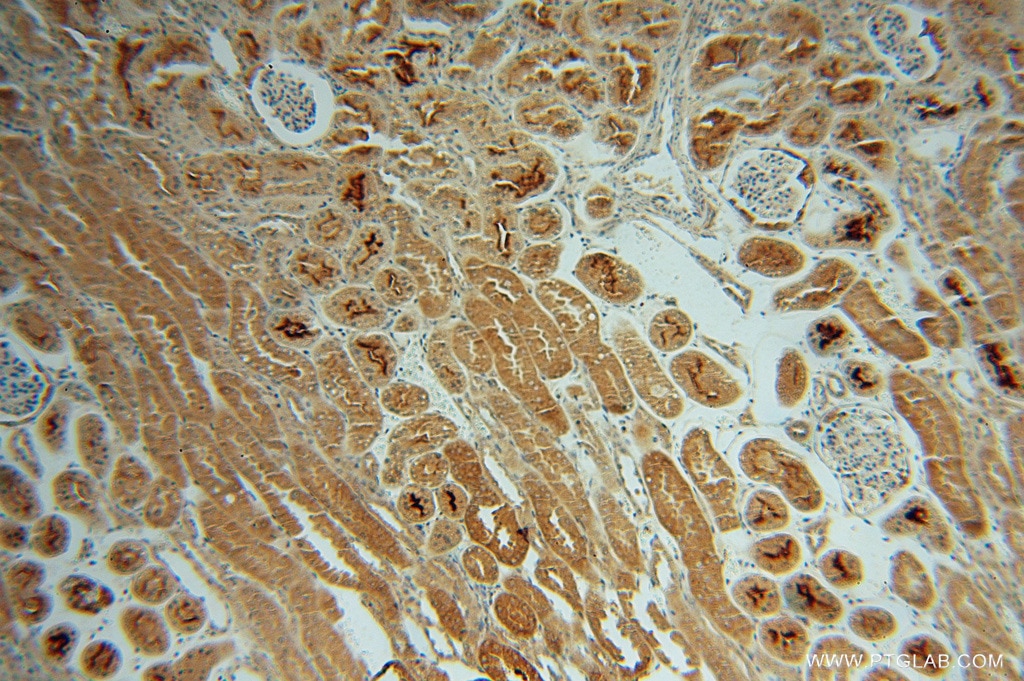- Phare
- Validé par KD/KO
Anticorps Polyclonal de lapin anti-CHMP7
CHMP7 Polyclonal Antibody for WB, IF, IHC, ELISA
Hôte / Isotype
Lapin / IgG
Réactivité testée
Humain, rat, souris et plus (1)
Applications
WB, IHC, IF/ICC, IP, ELISA
Conjugaison
Non conjugué
N° de cat : 16424-1-AP
Synonymes
Galerie de données de validation
Applications testées
| Résultats positifs en WB | cellules HEK-293, cellules HEK-293T, cellules HeLa, cellules Jurkat, tissu de moelle épinière de rat, tissu de moelle épinière de souris |
| Résultats positifs en IHC | tissu rénal humain, il est suggéré de démasquer l'antigène avec un tampon de TE buffer pH 9.0; (*) À défaut, 'le démasquage de l'antigène peut être 'effectué avec un tampon citrate pH 6,0. |
| Résultats positifs en IF/ICC | cellules A431, |
Dilution recommandée
| Application | Dilution |
|---|---|
| Western Blot (WB) | WB : 1:2000-1:16000 |
| Immunohistochimie (IHC) | IHC : 1:50-1:500 |
| Immunofluorescence (IF)/ICC | IF/ICC : 1:200-1:800 |
| It is recommended that this reagent should be titrated in each testing system to obtain optimal results. | |
| Sample-dependent, check data in validation data gallery | |
Applications publiées
| KD/KO | See 5 publications below |
| WB | See 8 publications below |
| IHC | See 1 publications below |
| IF | See 2 publications below |
| IP | See 2 publications below |
Informations sur le produit
16424-1-AP cible CHMP7 dans les applications de WB, IHC, IF/ICC, IP, ELISA et montre une réactivité avec des échantillons Humain, rat, souris
| Réactivité | Humain, rat, souris |
| Réactivité citée | Humain, porc |
| Hôte / Isotype | Lapin / IgG |
| Clonalité | Polyclonal |
| Type | Anticorps |
| Immunogène | CHMP7 Protéine recombinante Ag9625 |
| Nom complet | CHMP family, member 7 |
| Masse moléculaire calculée | 453 aa, 51 kDa |
| Poids moléculaire observé | 51-55 kDa |
| Numéro d’acquisition GenBank | BC019110 |
| Symbole du gène | CHMP7 |
| Identification du gène (NCBI) | 91782 |
| Conjugaison | Non conjugué |
| Forme | Liquide |
| Méthode de purification | Purification par affinité contre l'antigène |
| Tampon de stockage | PBS avec azoture de sodium à 0,02 % et glycérol à 50 % pH 7,3 |
| Conditions de stockage | Stocker à -20°C. Stable pendant un an après l'expédition. L'aliquotage n'est pas nécessaire pour le stockage à -20oC Les 20ul contiennent 0,1% de BSA. |
Protocole
| Product Specific Protocols | |
|---|---|
| WB protocol for CHMP7 antibody 16424-1-AP | Download protocol |
| IHC protocol for CHMP7 antibody 16424-1-AP | Download protocol |
| IF protocol for CHMP7 antibody 16424-1-AP | Download protocol |
| Standard Protocols | |
|---|---|
| Click here to view our Standard Protocols |
Publications
| Species | Application | Title |
|---|---|---|
Nat Cell Biol Unrestrained ESCRT-III drives micronuclear catastrophe and chromosome fragmentation.
| ||
Dev Cell CC2D1B Coordinates ESCRT-III Activity during the Mitotic Reformation of the Nuclear Envelope.
| ||
Dev Cell The ESCRT machinery counteracts Nesprin-2G-mediated mechanical forces during nuclear envelope repair.
| ||
Curr Biol Membrane Binding by CHMP7 Coordinates ESCRT-III-Dependent Nuclear Envelope Reformation.
| ||
PLoS Pathog Cellular ESCRT components are recruited to regulate the endocytic trafficking and RNA replication compartment assembly during classical swine fever virus infection. |
Avis
The reviews below have been submitted by verified Proteintech customers who received an incentive forproviding their feedback.
FH Viviana (Verified Customer) (06-01-2022) | Very good to IP endogenous protein from mouse tissue (2 ug for less than 2mg of total protein tested) and also for western blot.
 |









